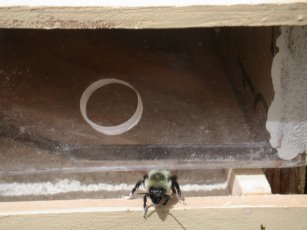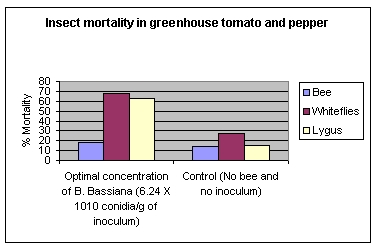Results from the Pesticide Risk Reduction Program
Greenhouse tomatoes and sweet peppers are economically important crops that require rigorous pest and disease control. Most greenhouse growers employ an integrated pest management (IPM) approach involving cultural, chemical and biological strategies to control insects and diseases attacking their crops. Some chemical pesticides carry with them disadvantages when used in these systems: they are costly; they can be inconvenient to use due to re-entry constraints and pre-harvest intervals; and they pose risks to beneficial organisms, including pollinators used in greenhouse vegetable production.
Biopesticides are good alternatives for use in these systems, and one example, the bioinsecticide Botanigard® has recently been registered for use in Canadian greenhouses. A new technique has been developed for the application of biocontrol agents like Botanigard®. This technique makes use of bumblebees, already active as pollinators in greenhouses, to disseminate microbial biocontrol agents to the flowers and leaves of pest-infested crops.

Photo: Bee exits hive carrying biopesticide
The Pest Management Centre’s Pesticide Risk Reduction Program has funded two studies investigating this new application method on greenhouse tomatoes and sweet peppers. Two microbial agents were used in the studies: the bioinsecticide BotaniGard® 22WP (B. bassiana) for control of whitefly in tomatoes and tarnished plant bugs in sweet peppers; and the growth stimulator EndoFine® (Clonostachys rosea) (ADJ 710 OMRI), which has been shown to suppress grey mould (Botrytis cinerea) in the same two crops.
Approach
Trials were conducted in enclosed compartments (screened cages) inside greenhouses. Each cage contained one bee colony consisting of 50 workers and one queen. A wooden dispenser containing the biocontrol agent was installed at the entry/exit of the hive, such that the bees picked up the agents as they exited through the dispenser in the course of pollination activities.
Trials identified the optimal concentration of B. bassiana as distributed by bees both for efficacy against the target pests and to minimize any negative impacts on bee health. The studies also determined the optimal concentration when two microbial agents are simultaneously delivered by bees. Potential impacts on the beneficial organism Eretmocerus eremicus were assessed and the impact on pollination efficiency was also evaluated.
The work was carried out by Dr. Les Shipp, Research Scientist with Agriculture and Agri-Food Canada (AAFC) in Harrow, Ontario, in collaboration with the AAFC research centre in London, Ontario and the University of Guelph. Biobest Canada Ltd., Adjuvants Plus Inc. and Laverlam International Corporation, the suppliers of the pollinating agents and biopesticides, also contributed to the work.
Results
The application of the microbial biocontrol agent B. bassiana, alone or combined with the growth stimulator C. rosea, by the bees was found to be an effective technique for controlling whitefly and tarnished plant bugs and suppressing grey mould in tomato and sweet pepper crops.

Graph: Insect mortality in greenhouse tomato and pepper.
Description of above image
| Insects | Optimal concentration of B. Bassiana (6.24 × 1010 conidia/g of inoculum) % Mortality |
Control (No bee and no inoculum) % Mortality |
|---|---|---|
| Bee | 18 | 14 |
| Whiteflies | 68 | 28 |
| Lygus | 62 | 16 |

Graph: Grey mould suppression on tomato and pepper.
Description of above image
| Plant | Grey mould on tomato % Disease Suppression |
Grey mould on pepper % Disease Suppression |
|---|---|---|
| Flower | 59 | 60 |
| Leaf | 50 | 48 |
The optimal concentration of B. bassiana destroyed approximately 70% of the tarnished plants bugs and approximately 55% of the whiteflies, without causing abnormal bee mortality rate. In addition, the results indicated that the simultaneous application of two biocontrol agents (B. bassiana and C. rosea) by bees is possible and effective. Whiteflies were suppressed by 68% in tomatoes, and tarnished plant bugs were suppressed by 63% in sweet peppers. Grey mould was suppressed by approximately 60% on the flowers and by approximately 50% on the leaves of tomatoes and sweet peppers as compared to untreated control plants.
No adverse effect was detected on E. eremicus as a result of the simultaneous use of B. bassiana and C. rosea. This is an important finding since E. eremicus is used by greenhouse growers for biological control of whitefly in tomatoes. Its rate of parasitism remained at approximately the same level when compared to E. eremicus not exposed to B. bassiana.
The trials conducted in commercial greenhouse tomato crops showed that pollination by the bees was satisfactory and that the yield and quality of the tomatoes harvested met the recommended commercial standards.
Benefits
- A number of benefits are evident with this novel approach:
- Simultaneous performance of two operations (pollination and pest control
- Continuous, targeted application of biocontrol agents
- Easy to use and requires little time
- Minimum labour costs for application
- No re-entry or pre-harvest intervals
- Substantial reduction of the need for chemical pesticides used in greenhouses
- Compatibility with bio-based IPM programs currently in place in greenhouses